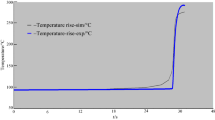Abstract
Isoprene is an important material used in the synthetic rubber industry, the applications have been extensively studied, but research into the safe use of this substance has been scanty. The lack of safety information has become worrisome, and this study focuses on an evaluation of the hazardous properties of isoprene. Thermal analysis of the heat polymerization and exothermic characteristics of isoprene mixed with contaminating substances was done using DSC, and the results provide valuable information that engineers can use to avoid the danger of accidents. Isoprene is flammable and can be unstable. This presents the danger of explosion and fire in the presence of air and an ignition source. Thermal analysis was carried out for isoprene and isoprene mixed with contaminating substances. From the experiments with contaminating substances, it can be seen that contamination can accelerate the decomposition reaction of isoprene.


















Similar content being viewed by others
Abbreviations
- T 0 :
-
Exothermic onset temperature (°C)
- T 0i :
-
Exothermic onset temperatures of different scanning rates (°C); i = 1, 2, 3, 4
- T f :
-
Final temperature (°C)
- T P :
-
Peak temperature (°C)
References
Meijer J, Hogt AH, Fischer B. Organic peroxides in radical synthesis reactions. Acros Organics, 07/15/2012.
Central Occupational Safety and Health Center, OSHA. Occupation accident cases inquiry system. Date of browse 07/15/2012.
Shih HC. 2012 petrochemical industry yearbook. Hsinchu: IEK, Industrial Technology Research Institute; 2012.
Carşote C, Badea E, Miu L, Della Gatta G. Study of the effect of tannins and animal species on the thermal stability of vegetable leather by differential scanning calorimetry. J Therm Anal Calorim. 2016;124:1255–66.
Guimarães D, Oliveira VA, Leão VA. Kinetic and thermal decomposition of ettringite synthesized from aqueous solutions. J Therm Anal Calorim. 2016;124:1679–89.
Holba P, Šesták J. Heat inertia and its role in thermal analysis. J Therm Anal Calorim. 2015;121:303–7.
Keidar O, Lapides I, Shoval S, Yariv S. Thermogravimetry and differential thermal analysis of montmorillonite treated with 1,4-diaminoanthraquinone. J Therm Anal Calorim. 2015;120:33–43.
Gupta YN, Abbas SM, Sharma RB, Setua DK. Crystallization kinetics of polyurethane nanocomposites. J Therm Anal Calorim. 2015;119:1393–405.
Singh S, Lal S, Kaistha N. Ind Eng Chem Res. 2008;47:7257.
Yi C, Yanchun L, Yunlong H. The correctional kinetic equation for the peak temperature in the differential thermal analysis. J Therm Anal Calorim. 2008;93:111.
Jones JC. On the extrapolation of results from oven heating tests for propensity to self-heating. Combust Flame. 2001;124:334–6.
Xie H, Cai A, Wang X. Thermal diffusivity and conductivity of multiwalled carbon nanotube arrays. Phys Lett A. 2007;369:120.
Ptacek P, Kubatova D, Havlica J, Brandstetr J, Soukal F, Opravil T. Isothermal kinetic analysis of the thermal decomposition of kaolinite: the thermogravimetric study. Thermochim Acta. 2010;501:24–9.
Vijayaraghavan R, Surianarayanan M, MacFarlane DR. Adiabatic calorimetry of telomerization reactions in ionic liquids. Ind Eng Chem Res. 2007;46:1025.
Factor affair data, LCY Chemical Corp. 2012.
Author information
Authors and Affiliations
Corresponding author
Rights and permissions
About this article
Cite this article
Liu, K.C., Wang, C.J., Lin, J.Z. et al. Thermal reaction hazard research for isoprene. J Therm Anal Calorim 129, 411–424 (2017). https://doi.org/10.1007/s10973-017-6113-y
Received:
Accepted:
Published:
Issue Date:
DOI: https://doi.org/10.1007/s10973-017-6113-y




